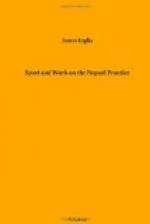It is sometimes wonderful how easily a large and powerful tiger may be killed. The most vulnerable parts are the back of the head, through the neck, and broadside on the chest. The neck is the most deadly spot of all, and a shot behind the shoulder, or on the spine, is sure to bring the game to bag. I have seen several shot with a single bullet from a smooth-bore, and on one occasion, George tells me he saw a tigress killed with a single smooth-bore bullet at over a hundred yards. The bullet was a ricochet, and struck the tigress below the chest, and travelled towards the heart, but without touching it. She fell twenty yards from where she had been hit. Another, which on skinning we found had been shot through the heart, with a single smooth-bore bullet at a distance of one hundred and fifty yards, travelled for thirty yards before falling dead. Meiselback, a neighbour of mine, shot three tigers successively, on one occasion, with a No. 18 Joe Manton smooth-bore. Each of the three was killed by a single bullet, one in the head, one in the neck, and one through the heart, the bullet entering behind the shoulder.
On the other hand, I once fired no less than six Jacob’s shells into a tiger, all behind the shoulder, before I could stop him. The shells seemed to explode on the surface the moment they came in contact with the body. There was a tremendous surface wound, big enough to put a pumpkin into, but very little internal hurt. On another occasion (April 4, 1874) during one of the most exciting and most glorious moments of my sporting life—buffaloes charging the line in all directions, burning jungle all around us, and bullets whistling on every side—I fired TWELVE shells into a large bull before I killed him. As every shell hit him, I heard the sharp detonation, and saw the tiny puff of smoke curl outward from the ghastly wound. The poor maddened brute would drop on his knees, stagger again to his feet, and, game to the last, attempt to charge my elephant. I was anxious really to test the effect of the Jacob’s shell as against the solid conical bullet, and carefully watched the result of each shot. My weapon was a beautifully finished No. 12 smooth-bore, made expressly to order for an officer in the Royal Artillery, from whom I bought it. From that day I never fired another Jacob’s shell.
My remarks about the tiger springing clear off the ground when charging, are amply borne out by the experience of some of my sporting friends. I could quote pages, but will content myself with one extract. It is a point of some importance, as many good old sportsmen pooh-pooh the idea, and maintain that the tiger merely stretches himself out to his fullest length, and if he does leave the ground, it is by a purely physical effort, pulling himself up by his claws.




